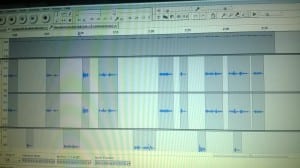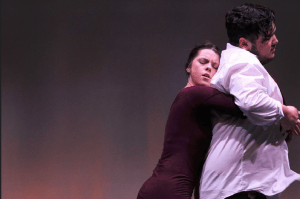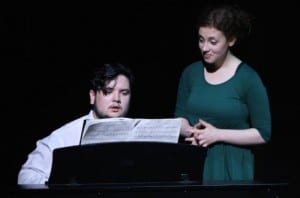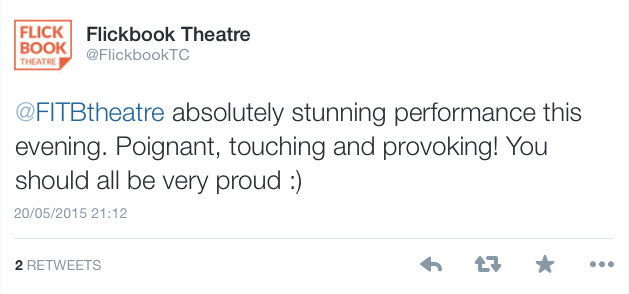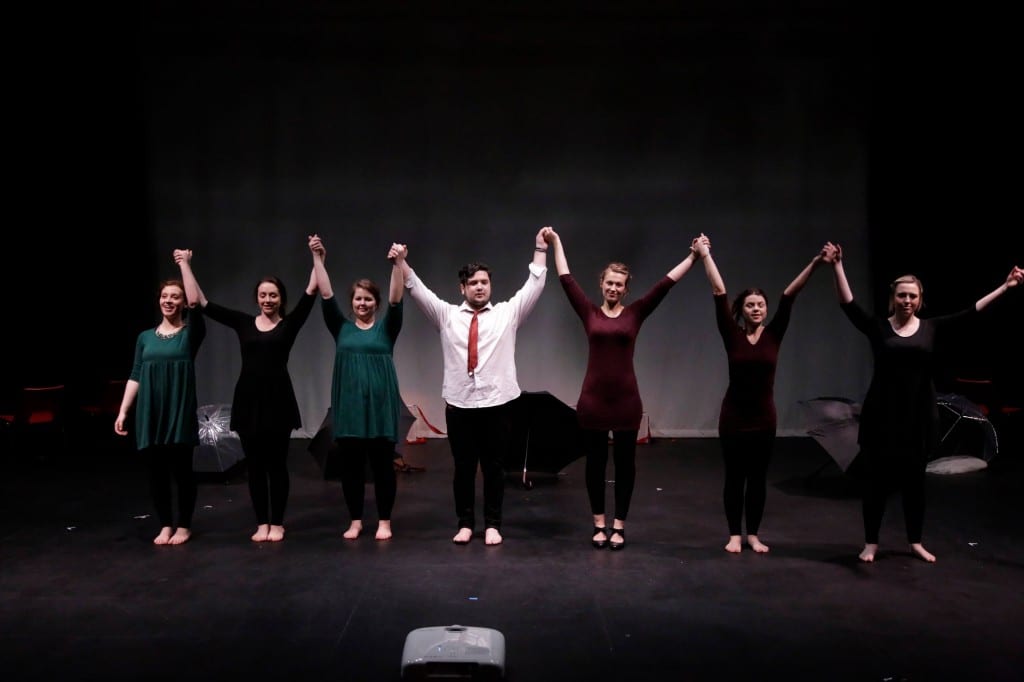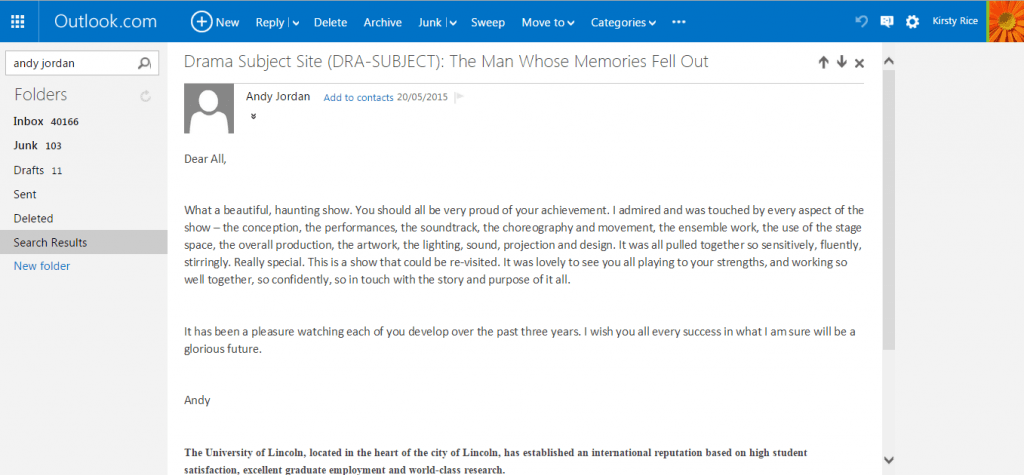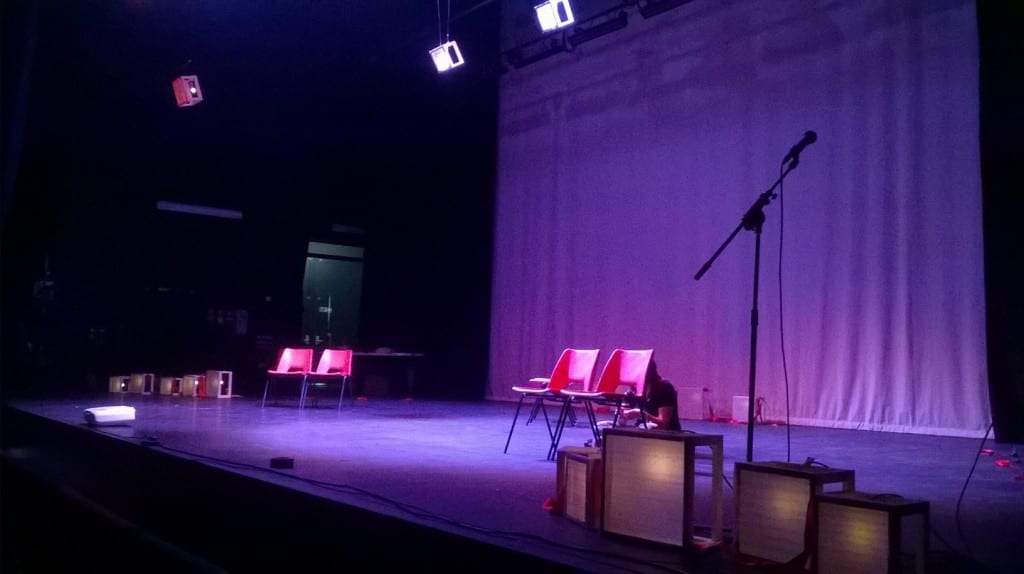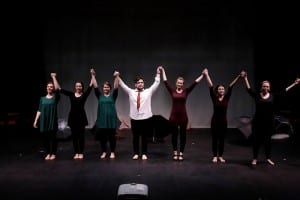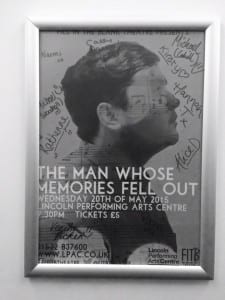Suddenly in the final weeks the process of devising and creating theatre seems to catch up on you as a theatre company, even more so as a Producer. The deadlines once set months before are days away and the final touches begin to take place.
We started as Fill In The Blank Theatre in January, at the start of our final term at University. The aspect of creating a fully functioning theatre company and producing our premier piece on the 20th May seemed a world away, but before we knew it we were in the venue’s auditorium tech-ing our show and seeing it come to life on the stage, out of the rehearsal space.
Our fantastic Stage Manager (Alice Saxton) and myself liaised to create several documents to ensure that the tech rehearsal and performance day both ran smoothly and we kept to schedule ensuring to make most of the time and space. In order to be productive in the space, Alice made sure that all of our technical requirements had already been created, such as lighting and sound cues and collated into Qlab to save time. Due to this we were able to do a full run in the space which we didn’t expect. It was a great opportunity to try the piece in the space and make necessary changes that we would of otherwise not known, for example certain blocking.
After a smooth productive tech rehearsal it was back to rehearsals to fine tune the piece. During this time it was my job in rehearsals to make notes during run through’s, although admittedly these notes became picky in the end but it was such notes that made the difference in making sure the piece was fluid and polished especially in aspects such as the choreography, where a foot out of place could make the scene look ‘sloppy’. During this fine tuning process, one element that I found vital was the presence of outside eyes. Nearing the end of our process we as a company invited our tutor and peers to come and witness our several ‘work in progresses’ and give us feedback. This is something I will most definitely carry with me from this experience as individuals outside of the company can pick up on things which you would have never thought to question due to being so involved with the project.
Due to our tech rehearsal being so successful thanks to our Stage Manager, Lighting Designer and Sound Designer being on top of things, it enabled us to make small changes on the performance day, such as re-recording voice over’s and changing projections due to our lighting and sound designers being experienced in using Qlab.
Yet again, Myself and Alice S planned our get in for the show day, it followed the below schedule:
9am- SM, ASM, SD, LD, PD and DESIGNER called at this time. Please try to arrive 10 minutes early as this means we can keep to schedule.
9-10.30am – Technical Set-Up. DESIGNER in charge of stage set up:
Hannah and Verity to set up stage boxes and props.
Katherine (and possibly Alice S) to set up hanging boxes.
Naomi to set piano on stage (to help Katherine after)
This time will be used to mark out the 8 chairs and centre stage, make any lighting changes and set up the projector(s).
CAST ON STANDBY FROM 10am – All cast and company members should enter through the back stage door as opposed to the auditorium. The code is 1930. Please stay in the dressing room unless you are called. Be ready in costume for Tech run.
11-11.50am – Full Tech run.
11.50am- 12.15pm – Notes and Lighting edits.
12.15–1.45pm – Lunch break. Everyone needs to return and be ready for no later than 2pm.
2-2.25pm – Cast warm up, DESIGNER to check props.
2.30-3.30pm – Dress Run. Full run of performance as though would be performed on the night. No stopping, if mistakes are made they are to be addressed at the end.
3.30pm–4.00pm – Feedback (Split; Verity = Performers and Alice = Technical)
4pm – 6pm – Dinner. If you leave the building please change out of your costume.
6pm – CALL FOR ALL CAST MEMBERS TO RETURN.
6.15pm – 6.45pm – Physical and vocal warm-up on stage. PR, SM and DR to check set and props. Performers to get in to costume.
6.40pm – HALF HOUR CALL.
6.55pm – 15 MINUTE CALL
7.10pm – BEGINNERS CALL
7.15pm – BEGIN PRESET
7.15pm – DOORS OPEN.
7.30pm – SHOW.
8.20pm – SHOW ENDS.
8.30pm – GET OUT BEGINS.
All in all we stuck closely to the schedule, perhaps being 10 minutes behind there or there abouts in which we shortened our first dinner break as we had notes to adjust technical requirements and some last minute blocking issues. We had quite an early first full run as we wanted to ‘warm up’ and get the cast used to the space whilst checking all the tech to ensure we had time to make changes, as well as the fact that we had Phil Crow, a professional photographer coming in to take pictures of our dress run at 2.30pm.
Following two fantastic dress runs, before we knew it, it was time for beginners call and the doors opened. I couldn’t be prouder of how the show went, all the cast gave it their all and were dedicated to such intense physical sequences. If I had to pick a favourite moment in the performance it would have to be the scene ‘waiting room’. Influenced by Frantic Assembly’s famous Chair Duets the scene was performed solely of movement and in complete silence, these being two reasons why I was particularly fond of it, but also the fact that it was relatable. Everyone at some point has received some sort of bad news and as people often say they have ‘no words’ to describe how they are feeling, thus its shown in the body. Even in reflection I still can’t quite comprehend the feedback we received from tutors, peers, family and friends. For example the response below;
“What a beautiful, haunting show…I admired and was touched by every aspect of the show – the conception, the performances, the soundtrack, the choreography and movement, the ensemble work, the use of the stage space, the overall productions, the artwork, the lighting, sound, projection and design. It was all pulled together so sensitively, fluently, stirringly. Really special” (Jordan, 2015).
The overall experience of being a part of organising, devising and creating a theatrical performance of a professional standard that people spoke of so highly is by far one of the most challenging yet greatest experiences I have been a part of. I have learnt many things throughout that I will carry with me after University.
It is for sure an experience that will go down in the memory book!
Works Cited:
Ficken, V., Saxton, A. (2015) FITB Performance Day Get In.
Jordan, A. (2015)
